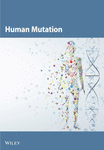Intronic mutations in the L1CAM gene may cause X-linked hydrocephalus by aberrant splicing†‡
Communicated by Mark H. Paalman
Online Citation: Human Mutation, Mutation in Brief #713 (2004) Onlinehttp://www3.interscience.wiley.com/homepages/38515/pdf/mutation/713.pdf
Abstract
L1 disease is a clinically heterogeneous X-chromosomal neurodevelopmental disorder that is frequently associated with mental retardation and congenital hydrocephalus in males. It is caused by mutations in L1CAM that encodes a multifunctional transmembrane neuronal cell adhesion molecule. We report our findings on 6 novel intronic L1CAM sequence variants (c.523+5G>A, c.1123+1G>A, c.1547-13delC, c.3323-17dupG, c.3457+3A>T, and c.3457+18C>T), and a recurrent one (c.523+12C>T). While the pathogenic potential of nucleotide changes within the evolutionarily well-conserved splice consensus sequence (c.523+5G>A, c.1123+1G>A, and c.3457+3A>T) is widely accepted, it is not always straight forward to assess the disease relevance of intronic mutations, if they lie outside the consensus. The c.523+12C>T variant co-segregated with X-linked hydrocephalus in two unrelated families. In the mutated allele, a preferentially used novel splice donor site is generated that results in a frame shift due to insertion of the first 10 bp of intron 5 in the mature mRNA, a largely truncated protein, and most likely a functional null allele. The c.1547-13delC mutation creates a new acceptor site resulting in the insertion of 4 additional amino acids at the end of the immunoglobulin like domain 5. In contrast, c.3323-17dupG and c.3457+18C>T seem to be non-pathogenic L1CAM variants. © 2004 Wiley-Liss, Inc.




